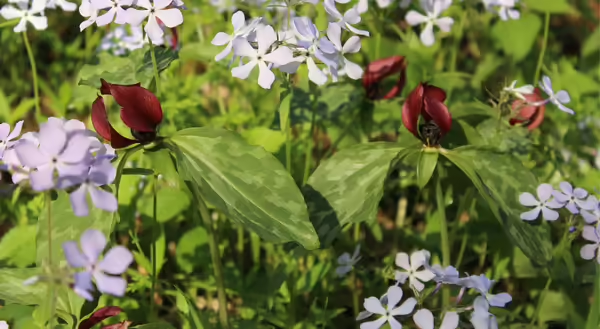
Originally published by Kelly Allsup on March 19, 2021.
Early spring is a great time to take a walk in the woods when the spring ephemerals are blooming. The small and short-lived flowers are able to make the most of water and sunlight reaching the ground. But once trees begin growing leaves, many ephemerals become inactive and are unnoticeable until the following spring. They fade out as quickly as they emerged, so time is of the essence.
Virginia bluebells (Mertensia virginica) is probably the most well-known spring ephemeral, producing many tubular blue flowers coveted by native bees. They are easy to grow forming a thicket of plants that disappears in later spring.
Dutchman’s breeches (Dicentra cucullaria) has foliage with an erect raceme of drooping white flowers that look like upside down pants, hence the name. The blooming period occurs from early to mid-spring and lasts about 2-3 weeks. They are related to bleeding hearts. The black seeds form in late May and have a white fleshy appendage that is attractive to ants as a food source. Ants carry the seeds to their nests, eat the appendage, and discard the seeds some distance from the original plant. These seeds will germinate the following spring.
Jack-in-the-Pulpit (Arisaema triphyllum) produces a rather unique shaped whitish green to reddish green flower, consisting of a spadix and spathe. A more recognizable spadix and spathe flower is Anthurium, also known as flamingo flower or painter’s pallet. A spathe is a large leaf-like surrounding, while the spadix is a smaller spike of very small flowers inside the spathe. The spathe is usually brightly colored to attract pollinators. Jack in the pulpit is pollinated by fungus gnats. The blooming period occurs from mid-to-late spring and lasts about 2 weeks, but the spathe and spadix remain on the plant for longer. After fertilization, each flower will develop a green then red fleshy fruit that becomes more prominent in the fall. Rather than planting the seeds, most gardeners plant corms. This plant can grow up to three feet tall on top of a few leaves.
Prairie trillium or purple trillium (Trillium recurvatum) emerges in May. Prairie trillium has deep burgundy flowers on top of whorled mottled dark and light green leaves growing to only a few inches tall. The maroon petals remind me of praying hands... of a three-handed person! The blooming period is mid-to-late spring, lasting about 3-4 weeks. Beetles and flies pollinate the flowers. The flowers are replaced by a small seed pod. These plants are also spread by rhizomes and this is how they are usually planted in a garden setting. They take time to establish before flowering occurs. The seeds of these plants are often distributed by ants, like Dutchman’s breeches, because of a similar edible appendage.
All of the above woodland wildflowers need dappled shade and rich, moist soils. Rich soils can be obtained by adding organic matter. These plants can be planted in late fall or early spring. Planting around and under deciduous trees will give them the benefit of leaf litter that protects them during the cold and adds to the richness of the soil. They should be planted with other plants because they are ephemeral, providing a show only in the early spring. Some garden centers may provide some of these Illinois spring woodland wildflowers, but searching local and online sources may be needed to find them.
Whether you decide to take on these plants in your garden or take a walk in your nearest forest, they will provide much delight and let us all know spring is finally here. For more native spring ephemerals, see the Red Oak Rain Garden's guide for the home gardener!
For more information, join the Candice, Ryan and Kelly on Facebook Live with the Horticulturists on March 25th at noon, which will cover everything you need to know about spring ephemerals with our special guest, Erin Garret. To join the live show at http://www.facebook.com/UIextension.
To view past live shows, visit https://go.illinois.edu/FacebookLive.